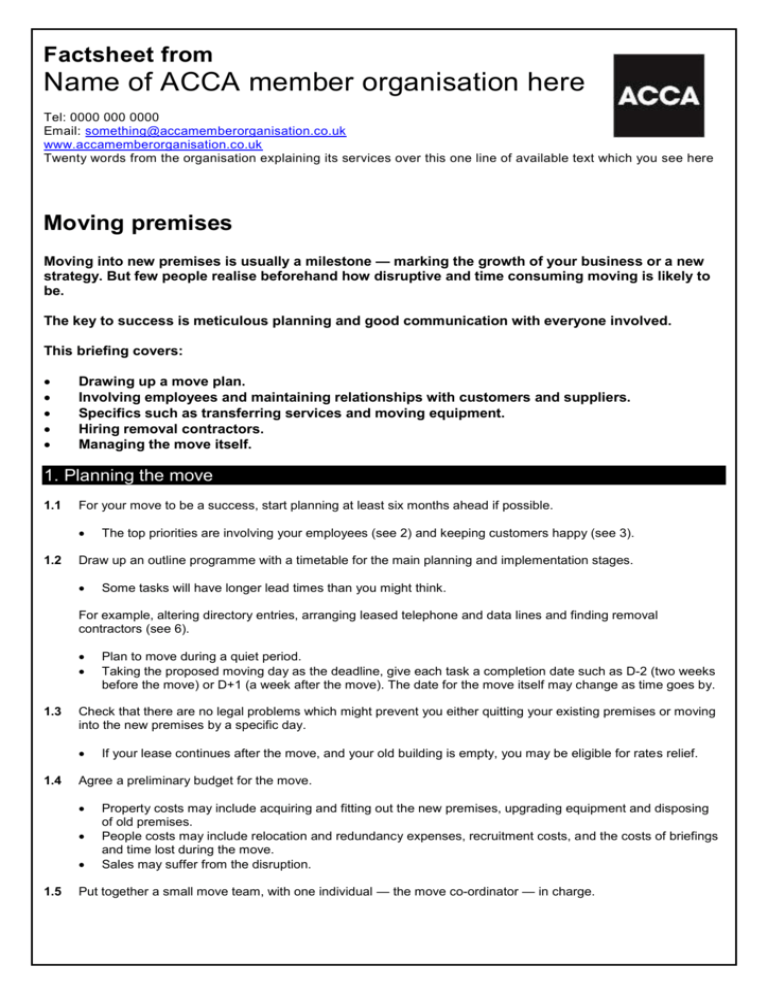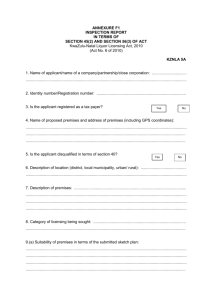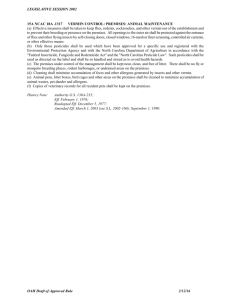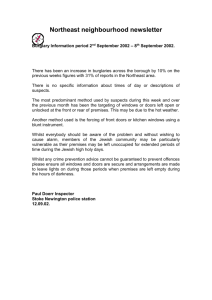
Factsheet from
Name of ACCA member organisation here
Tel: 0000 000 0000
Email: something@accamemberorganisation.co.uk
www.accamemberorganisation.co.uk
Twenty words from the organisation explaining its services over this one line of available text which you see here
Moving premises
Moving into new premises is usually a milestone — marking the growth of your business or a new
strategy. But few people realise beforehand how disruptive and time consuming moving is likely to
be.
The key to success is meticulous planning and good communication with everyone involved.
This briefing covers:
Drawing up a move plan.
Involving employees and maintaining relationships with customers and suppliers.
Specifics such as transferring services and moving equipment.
Hiring removal contractors.
Managing the move itself.
1. Planning the move
1.1
For your move to be a success, start planning at least six months ahead if possible.
1.2
The top priorities are involving your employees (see 2) and keeping customers happy (see 3).
Draw up an outline programme with a timetable for the main planning and implementation stages.
Some tasks will have longer lead times than you might think.
For example, altering directory entries, arranging leased telephone and data lines and finding removal
contractors (see 6).
1.3
Check that there are no legal problems which might prevent you either quitting your existing premises or moving
into the new premises by a specific day.
1.4
If your lease continues after the move, and your old building is empty, you may be eligible for rates relief.
Agree a preliminary budget for the move.
1.5
Plan to move during a quiet period.
Taking the proposed moving day as the deadline, give each task a completion date such as D-2 (two weeks
before the move) or D+1 (a week after the move). The date for the move itself may change as time goes by.
Property costs may include acquiring and fitting out the new premises, upgrading equipment and disposing
of old premises.
People costs may include relocation and redundancy expenses, recruitment costs, and the costs of briefings
and time lost during the move.
Sales may suffer from the disruption.
Put together a small move team, with one individual — the move co-ordinator — in charge.
The move co-ordinator can liaise with other employees, the removal company and any other subcontractors.
The co-ordinator will delegate specific areas of responsibility to individual members of the team.
For example, space planning and furniture arrangement; moving IT equipment; telecoms and data; regulations;
and health and safety.
Employees can draw up their own task lists, in date order, to meet the completion dates in the outline
programme.
Ensure each individual has enough time to carry out the tasks.
1.6
Timetable regular meetings to co-ordinate progress and keep the momentum going.
Plans and costs will need to be agreed.
Take advantage of the help available from your chosen removal company by bringing the contractors in on
planning meetings.
2. Involving employees
2.1
Consult all your employees — and trade union representatives if applicable — well in advance of the planned
move.
Without adequate consultation, you run the risk of breaching rules on the consultation of employees and also the risk of
employees resigning.
2.2
Involve employees in your plans.
Keep employees up to date with briefings or presentations as the move progresses.
Moving premises will cause more problems with employees if it involves relocation.
Relocating without employees’ agreement could be a breach of their employment contracts, unless these
include a suitable ‘mobility clause’.
Relocation is not an acceptable reason for redundancy, unless the new location is too far away for
reasonable travelling.
Even then, you should offer your employees the chance to relocate and may want to offer some payment for the
expenses involved.
If employees are unable to relocate, you may be required to offer a redundancy package.
Recognise any hardship or expense that may result from the move, and agree any appropriate
compensation.
For example, employees may have to move house or change their children’s schools.
3. Maintaining relationships
3.1
Send a notice of change of address to your customers and suppliers well in advance.
Explain why you are moving and use it as a marketing opportunity.
For example, explain you have outgrown the old place and invite them to a party to mark the opening of your new
premises.
3.2
Where appropriate, include a map of how to find your new premises.
Key customers may merit a phone call or a visit to explain why you are moving.
Inform the authorities and other contacts.
2
Going through the files will reveal contacts that may not be on your database.
For example, banks, credit card issuers, professional advisers, insurers and couriers.
3.3
Order stationery showing the new address.
For example, letterheads, envelopes, address labels, compliment slips and business cards.
3.4
Amend all advertising and promotional material to show the new address.
3.5
Get written confirmation of any new telephone and fax numbers, and your postcode, before going ahead.
Notify any databases and directories which have your old address.
Update your website with your new address.
Amend any current advertising.
If you are not printing new brochures with your new contact details, order change of address stickers to put
on existing ones.
Set up a ‘business as usual’ team, with the specific task of maintaining customer service levels throughout the
move period.
4. Transfer services
4.1
Redirect mail to the new address.
4.2
Obtain a Redirection Application form at your local Post Office or call 08457 740 740. You can also download
a form from www.royalmail.com. Complete the form and apply by post or at the Post Office at least five
working days before you move. The cost depends on how long the mail is redirected for.
Re-register your franking equipment if you move to a new postal district.
Contact your telecoms provider and request information on how to move premises with minimum inconvenience.
Check with them if you can:
take your old number with you
leave your new number as a message recorded on your old number (‘ceased number interception’)
divert telephone and fax calls to the new numbers (‘remote call forwarding’) — if the expense is justified
Check the costs and the minimum periods for these services.
4.3
At least 14 days beforehand, arrange for all utilities to be cut off, and all meters to be read, at the end of the
moving day.
4.4
In some cases, you may need to find new suppliers and end existing contracts.
4.5
Read the meters yourself as well, and keep a written record.
For example, office and window cleaning, waste disposal and maintenance.
Notify your insurer of the move and arrange any new insurance that is necessary.
5. Equipment and fit-out
If customers get poor service or cannot contact you during the move, your business will suffer.
5.1
You will need a business continuity back-up plan to ensure that you can continue to operate, even if the
unexpected happens.
3
5.2
To minimise downtime, consider using a specialist company to decommission and recommission your PCs,
servers and office machines. Larger removal companies can provide IT relocation services.
A separate move co-ordinator may be needed for the IT element of the project, working alongside the main
move team.
Draw up a detailed configuration plan for your telephone and computer systems. You may need to re-wire the
new premises.
Work out where you will need power outlets, telephone points and computer points (if your computers are
networked).
Avoid sunlight glare on computer screens. Visit the premises at different times of day to see where this will be a
problem.
Decide the optimum locations for printers, faxes, copiers and scanners.
5.3
If you are buying new equipment, test it before you move and complete any necessary training.
5.4
Make any alterations to the new premises. For example, painting and new carpets.
You may need written permission from the landlord before making alterations.
6. Hiring a removal contractor
Unless you are a sole trader, you will need professional help for the move.
6.1
Draw up a detailed specification. List what has to be moved, when, and the addresses of the old and new
premises.
6.2
Arrange joint visits with removal companies to the new and old premises.
6.3
Note any relevant factors such as access. For example restricted parking.
Highlight any large or heavy items and any precious or fragile items.
Agree loading and off-loading points, and the broad timing of the move.
Confirm that the removers will make the arrangements for parking removal vans.
Confirm the number and type of crates required, when you need them, and when you want them collected
after the move.
Get detailed quotes from reputable removal companies and ask for references.
Cost breakdowns let you compare quotes. They also help you decide how much to spend and how much to
do yourself — for example, packing and unpacking.
6.4
Make sure your property is insured during the move. The removal contractor will be able to offer several different
levels of cover.
6.5
Devise an outline plan, with the removal company, including a contingency section. This will form the working
move document.
7. Move instructions
In the move instructions, spell out what each person must do, when, and how the move will be managed. A removal
contractor can manage many aspects of the move and give informed advice on what tends to go wrong.
7.1
Emphasise that one of the keys to success is the correct labelling of every item. Sorting it out later can be
disastrous. Devise a clear and unambiguous marking arrangement.
Floor plans of the new premises should be marked up to show where things go.
4
Use codes to show floor positions. For example 2.11 P4 might mean second floor, room 11, position 4.
7.2
The most common removal container is a plastic crate with a hinged lid. Attach coloured labels, which are
supplied, at each end. Make it clear how packing is to be handled.
7.3
Hire a shredder, or use a ‘secure disposal’ contractor, to deal with confidential data.
Consider storing some documents with a records management company.
Arrange for the local council to remove everything (eg furniture, files) that you wish to dispose of.
Explain how to code the contents of filing cabinets, drawers and shelves, so that you can put everything
back in the same order. For example, a container might read: “Cabine t 1, top shelf”.
7.6
Wires and cables should be taped to items and marked to show what plugs in where.
In the month before the move, dedicate at least one day to clearing out old files and clutter.
7.5
State when the crates will be available for packing, when they will be moved, and when they must be ready
to go back. Crates returned late may incur extra costs.
Crates should not be over-filled (or they will not stack up and may be impossible to lift) and all old labels
should be removed.
The removal company can pack central files, kitchen and stationery items, and everything else that is
agreed.
Use sealable crates for confidential files.
Explain the plans for moving equipment, including phones, PCs and any machinery.
7.4
Colour coding is simple and effective.
Open plan offices can be divided into sectors. The ‘sector map’ is then displayed on the door, so the
removers know where to place each item.
Label large items at each end.
When numbering items without an obvious top side, beware of confusion between 6 and 9. Underline the
number (6 or 9) to avoid misunderstandings.
Lockable filing cabinets can be moved full, depending on their size and weight..
Secure empty rails or shelves.
Include a move schedule, which lists the sequence of what is moved when , and details of how everything is
coded.
Decide what you will need last in the old premises and first at the new premises.
Contractors generally prefer to fill the new premises from the top down.
8. Managing the move
8.1
If the removal company is not doing the packing, check that everyone is using the agreed labelling and packing
procedures.
8.2
Decide a rota for who will be where, when.
Decide how your move co-ordinator will communicate with the removal company.
Arrange when employees should arrive at the new premises to unpack.
8.3
At the new premises, set up a help desk where people can note problems as they occur. Then prioritise what to
sort out first.
8.4
At the old premises, complete the handover arrangements.
This may include cleaning up, making good damage and handing over the keys.
5
Leaving the premises in good condition may reduce your liability for repair and redecoration costs.
8.5
Make the move a team effort. Keep up employee morale by showing your gratitude.
A little generosity in overtime pay and providing a meal will boost morale.
Notes
If you are a medium-sized company, relocation of people is particularly complicated. The Association of Relocation
Professionals (0800 074 5335; www.arp-relocation.com) offers a searchable members’ directory on their website.
Experts’ quotes
“Even if your employment contracts include a mobility clause, you still have to be reasonable. To take an extreme
example, you are not entitled to expect an employee to relocate from John O’Groats to Land’s End over the weekend.”
Amanda Galashan, EmployEase
Last updated 01.06.11
© BHP Information Solutions 2011. ISSN 1369-1996. All rights reserved. No part of this publication may be reproduced or transmitted without the
written permission of the publisher. This publication is for general guidance only. The publisher, expert contributors and distributor disclaim all liability
for any errors or omissions. Consult your local business support organisation or your professional adviser for help and advice.
6







